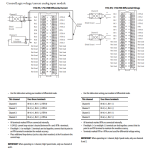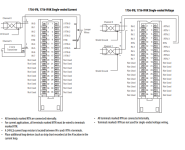Hello! I am trying to wrap my head around how to wire a 4-20mA sensor
to my AB 1756 ControlLogix IF8 Analog Input card. Could someone educate me on the purpose and use of the iRTN and RTN terminals on the card? (user manual image attached).
For my purpose, I have a 4-20mA ultrasonic flow meter that gives signal to a controller that connects to my analog input card via a single output wire (4-20mA). The controller has a wire for +24 and another for 0V which I plan on hooking up to +24 and 0V terminal boards connected to my power supply the PLC uses. I want to use channel 2 so I am planning on connecting the output wire to Input 4 (terminal 12) and having Input 5 (terminal 14) connect to 0V to complete the circuit. I am wondering if I am missing something by not utilizing the RTN/iRTN but I don't know because I am not sure what the purpose of those terminals is for.
From the user manual, it seems like those terminals are used primarily for differential mode, but I am not sure how to tell if that mode is what I need
to use for this ultrasonic sensor. Any answers you could give me or resources to understand this concept would be appreciated!


to my AB 1756 ControlLogix IF8 Analog Input card. Could someone educate me on the purpose and use of the iRTN and RTN terminals on the card? (user manual image attached).
For my purpose, I have a 4-20mA ultrasonic flow meter that gives signal to a controller that connects to my analog input card via a single output wire (4-20mA). The controller has a wire for +24 and another for 0V which I plan on hooking up to +24 and 0V terminal boards connected to my power supply the PLC uses. I want to use channel 2 so I am planning on connecting the output wire to Input 4 (terminal 12) and having Input 5 (terminal 14) connect to 0V to complete the circuit. I am wondering if I am missing something by not utilizing the RTN/iRTN but I don't know because I am not sure what the purpose of those terminals is for.
From the user manual, it seems like those terminals are used primarily for differential mode, but I am not sure how to tell if that mode is what I need
to use for this ultrasonic sensor. Any answers you could give me or resources to understand this concept would be appreciated!




